Scar treatments are diverse and tailored to the specific types and characteristics of scars, addressing both their aesthetic and functional impacts. Here’s a brief overview of three notable scar treatment methods:
- Burn Scar Reconstruction: This treatment is specialized for scars resulting from burns, which can be particularly challenging due to the extensive skin damage they often cause. Burn scar reconstruction may involve a variety of techniques, including skin grafts, where healthy skin is transplanted to the affected area, and laser therapy, which can improve the texture and color of burn scars. This method aims to restore functionality and improve the cosmetic appearance of the scarred area, which might be crucial for the patient’s mobility and comfort.
- Scar Camouflaging: This approach focuses on making scars less noticeable rather than removing them entirely. Techniques include medical tattooing, which implants pigment into the scarred area to match the surrounding skin tone, and micropigmentation, a procedure that uses detailed, fine tattoos to mimic the appearance of skin texture or hair, which can be particularly effective for areas where scars have caused pigment loss or disruption of natural features. Scar camouflaging is often preferred for scars that are difficult to remove or minimize through surgical means.
- Scar Revision: Scar revision is a surgical procedure aimed at improving the condition or appearance of a scar by altering its size, depth, or color. This can involve cutting out the old scar and meticulously closing the new wound, often in a less noticeable pattern or location. Additionally, for raised or hypertrophic scars, techniques such as dermabrasion (smoothing the top layers of skin) or laser therapy might be employed to blend the scar more seamlessly with the surrounding skin. Scar revision is often considered when scars are raised, puckered, or otherwise prominent, and there’s a potential for aesthetic or functional improvement.
Each of these treatments comes with its own set of considerations, such as the scar’s age, location, and the patient’s skin type and overall health. Consulting with a specialist is crucial to determine the most appropriate treatment plan.







